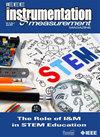基于优化Hilbert-Huang变换的非平稳信号测量数据时频域检测方法
IF 1.6
4区 工程技术
Q3 ENGINEERING, ELECTRICAL & ELECTRONIC
引用次数: 0
摘要
针对Hilbert-Huang变换(HHT)用于非平稳信号测量数据处理时存在的模式混合和信息冗余现象,提出了一种优化的HHT算法。通过设置互补集成经验模式分解而不是经验模式分解,使用频域平滑向量对谱进行平滑和边缘谱反馈以优化时频谱,提高了处理效果。将优化算法应用于南美白对虾声学信号的测量数据处理。获得了信号的持续时间、频率范围和0~24kHz范围内频率的相对强度。同时,通过对信号进行处理得到的优化时频谱,以及在不同平滑向量和反馈时间下得到的关键信息点数量的分布图,证明了算法的优化性能受到信号质量和平滑向量选择的影响。此外,在提取信号特征时,需要对初级和次级反馈结果进行积分。本文章由计算机程序翻译,如有差异,请以英文原文为准。
A Time-Frequency Domain Detection Method for Measurement Data of Non-Stationary Signals Based on Optimized Hilbert-Huang Transform
Aiming at the phenomenon of mode mixing and information redundancy when Hilbert-Huang transform (HHT) is used for non-stationary signal measurement data processing, an optimized HHT algorithm is proposed in the study. The processing effect is improved by setting complementary ensemble empirical mode decomposition instead of empirical mode decomposition, using a frequency-domain smoothing vector to smooth and marginal spectrum feedback to optimize the time-frequency spectrum. The optimized algorithm is applied to the measurement data processing of acoustic signals of Penaeus vannamei. The duration, the range of the frequency, and the relative intensity of the frequency within 0~24 kHz of the signals are obtained. Mean-while, the optimized time-frequency spectrums obtained by processing the signals and the distribution diagrams of the number of key information points obtained under different smoothing vectors and feedback times prove that the optimized performance of the algorithm is affected by the signal quality and the selection of smoothing vectors. Besides, the primary and secondary feedback results need to be integrated when extracting signal features.
求助全文
通过发布文献求助,成功后即可免费获取论文全文。
去求助
来源期刊

IEEE Instrumentation & Measurement Magazine
工程技术-工程:电子与电气
CiteScore
4.20
自引率
4.80%
发文量
147
审稿时长
>12 weeks
期刊介绍:
IEEE Instrumentation & Measurement Magazine is a bimonthly publication. It publishes in February, April, June, August, October, and December of each year. The magazine covers a wide variety of topics in instrumentation, measurement, and systems that measure or instrument equipment or other systems. The magazine has the goal of providing readable introductions and overviews of technology in instrumentation and measurement to a wide engineering audience. It does this through articles, tutorials, columns, and departments. Its goal is to cross disciplines to encourage further research and development in instrumentation and measurement.
 求助内容:
求助内容: 应助结果提醒方式:
应助结果提醒方式:


